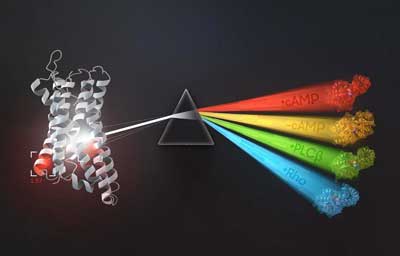| Jul 01, 2019 |
Coupled proteins
|
|
(Nanowerk News) Researchers from Heidelberg University and Sendai University in Japan used new biotechnological methods to study how human cells react to and further process external signals. They focussed on the interaction between so-called G-proteins - the "mediators" of signal transmission - and the receptors known as GPCRs, which trigger signal processes.
|
|
The researchers not only gained a better understanding of GPCR-G-protein interactions; they are now able to predict their functions better than before (Cell, "Illuminating G-Protein-Coupling Selectivity of GPCRs").
|
 |
| The image portrays which G-proteins bind to particular G-protein coupled receptors (GPCRs) and in turn how these are related to signalling events. (Image: Thomas Splettstoesser)
|
|
All living systems react to external signals from the environment. In humans and other animals, these signals are primarily detected and processed with biological receptors in the cell membrane that are coupled to the G-protein. These proteins have a key position in signal transmission.
|
|
The GPCRs, or G-protein coupled receptors, are the largest family of transmembrane receptors which can react to a multitude of extracellular, physico-chemical signals and then trigger specific processes in the cell. One way they do this is by coupling with one or more G-proteins.
|
|
In collaboration with colleagues from Japan, the team led by Prof. Dr Robert Russell of the Heidelberg University Biochemistry Center has now studied these couplings.
|
|
Humans have a total of 16 G-proteins that are coupled to nearly 1,000 different GPCRs. Using biotechnological tools and machine learning, the researchers closely investigated 148 representative receptors and 11 proteins to better understand the full breadth of GPCR-G-protein interactions. They were able to uncover several hundred coupling events, thus adding greatly to our understanding of how GPCRs work.
|
|
"Thanks to the new data, we can now predict GPCR-G-protein coupling better than ever before. It also allows us to design artificial GPCRs with very specific signalling properties for ultimate use in biomedical studies," explains the study's primary author Dr Francesco Raimondi.
|
|
He is a member of Prof. Russell's team, whose research group is also located at Heidelberg University's BioQuant Centre. The researchers assume that a better understanding of the interactions between GPCRs and G-proteins could also be important in the development of new drugs.
|

